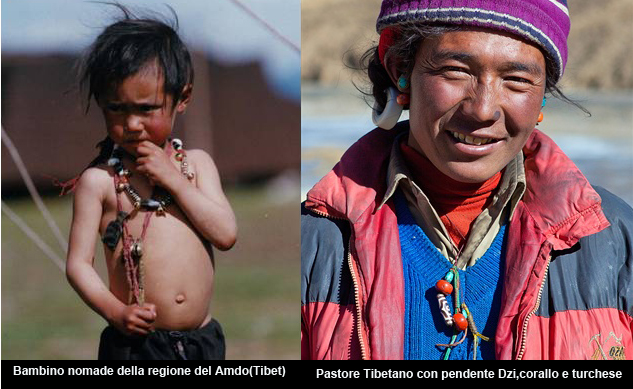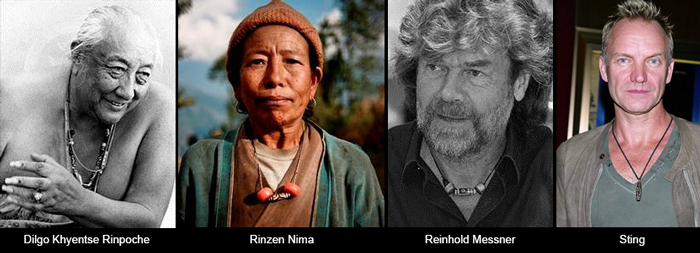 The choice as agate amulet is not accidental: the stones , such as metals, are conductors of energy and agate from time immemorial is considered a stone that radiates positive energy , for this reason it is suitable to become a good support physical / material which is associated with the mystical symbolism . Formed from a single tubular segment with specific symbolic reasons, the first models appeared in the chronicles Dzi were introduced in Tibet by warriors from Persia . Represented the extreme skill of the craftsmen engraving Persian , derived from techniques already been lost, and difficult to imitate .. The true origin of this stone is unknown. Stories passed down from generations tell of crushed meteorites found over four million years ago in Tibet , Bhutan, Sikkim and Ladhak before spreading throughout the region of Asia and the Himalayan centrale.Gli Dzi can also be agates natural shapes and patterns that are not etched falling within the sacred symbology Tibetan , in these cases their value is very high. After the exile of the Dalai Lama the first Tibetans who left for the United States used the Dzi to pay for hospitality or services received , given the lack of money. Acune of these stones have been preserved in the Metropolitan Museum of Art in New York. In the culture of the Tibetan ” Dzi ” are considered a blessing, a symbol of great social prestige and a very powerful amulet : not only are worn as pendants or bracelets just to protect the person, but in the ancient and the most traditional Tibetan medicine ” Dzi ” were crushed and the powder used as an ointment or diluted in particular drinks healing . Even today you can find examples of ” Dzi ” chipped or broken, are those in which a part has been removed for use as a medicine. Also adopted by the Chinese culture, ” Dzi ” became the name of ” stone of heaven ” as the correct translation would refer to a set of ” purity , splendor , brightness and brightness .
The choice as agate amulet is not accidental: the stones , such as metals, are conductors of energy and agate from time immemorial is considered a stone that radiates positive energy , for this reason it is suitable to become a good support physical / material which is associated with the mystical symbolism . Formed from a single tubular segment with specific symbolic reasons, the first models appeared in the chronicles Dzi were introduced in Tibet by warriors from Persia . Represented the extreme skill of the craftsmen engraving Persian , derived from techniques already been lost, and difficult to imitate .. The true origin of this stone is unknown. Stories passed down from generations tell of crushed meteorites found over four million years ago in Tibet , Bhutan, Sikkim and Ladhak before spreading throughout the region of Asia and the Himalayan centrale.Gli Dzi can also be agates natural shapes and patterns that are not etched falling within the sacred symbology Tibetan , in these cases their value is very high. After the exile of the Dalai Lama the first Tibetans who left for the United States used the Dzi to pay for hospitality or services received , given the lack of money. Acune of these stones have been preserved in the Metropolitan Museum of Art in New York. In the culture of the Tibetan ” Dzi ” are considered a blessing, a symbol of great social prestige and a very powerful amulet : not only are worn as pendants or bracelets just to protect the person, but in the ancient and the most traditional Tibetan medicine ” Dzi ” were crushed and the powder used as an ointment or diluted in particular drinks healing . Even today you can find examples of ” Dzi ” chipped or broken, are those in which a part has been removed for use as a medicine. Also adopted by the Chinese culture, ” Dzi ” became the name of ” stone of heaven ” as the correct translation would refer to a set of ” purity , splendor , brightness and brightness .

The meaning of the Tibetan word ” Dzi ” translates to ” shine , brightness , clearness, splendor. ” In Chinese it is called ” the pearl of heaven” ( ?) . The number of “eyes” on the stone is considered significant ; cover the points on designed circular grain . Depending on their number and arrangement, represent different meanings. Twelve is the highest number of eyes on an ancient Dzi . Any agate with more than twelve eyes is considered to be traditional nor authentic . The various stories or explanations that accompany the supposed benefits of Dzi with over thirteen eyes are believed to be false since they are part of the strategy employed around these sacred stones . The Dzi may appear in different colors , shapes and sizes , the surface is generally smooth and waxy , due to the use for long periods of time . Some points of color in Dzi are referred to as ” blood spots ” are small red spots in the white areas indicate a high concentration of cinnabar . This detail is highly desirable , but relatively rare. Another desirable effect is the so-called ” skin Naga ” which refers to a small circular marks on the atmospheric surface of the stone that resemble ladders . Some Dzi beads are simply polished agate using natural substances that do not have any special decorations. Dzi stones began with the tradition of Bon , the ancient animistic religion of Tibet, about 4000 years ago , but made their first appearance in history between 2000 and 1000 BC , in ancient India : a few hundred thousand warriors were reported by Tibetans from Persia or ancient Tajikistan at the end of a bloody battle . The widespread fear of the ” evil eye ” in retaliation of the vanquished was taken seriously, so those who owned the Dzi talisman , created with “eyes” on the surface could get a powerful form of spiritual protection against the enemies called ” fire fighting the fire. ” The first meteorites were small Dzi bead in tubular form , others in natural chalcedony both training they were found on the peaks of the Himalayas to the religious, spiritual preceptors or shamans. Looking at the great mystical properties of these objects the original creators considered the ‘ stone of agate as the basis for future elaboration of effective amulets. The shapes, eyes , and lines have been added to the rear with ancient methods that are not yet fully understood ; it is believed that the ‘ blackening and some of the lines Dzi emerge with plant sugars , heat, grease , clay , wax, or similar substances . After the color , shape and decoration of the ‘ agate has been reached , the filmmakers would drill the hole , a difficult job because in ancient times was to be introduced into thin strands . The softness and the absence of cracks in the stones imply that the processes of heating and bleaching took place at high altitude ( altitude Himalayan ) or some sort of ancient and rudimentary vacuum chamber with processing craft sophisticated and high precision . Although the geographic origin of Dzi beads is uncertain , it is recognized that in actuality are called ” Tibetan beads , ” just as “the Tibetan coral ” , arrived in Tibet to far off places. The Tibetans love these items and consider them gems hereditary . Due to their fascinating story ” stones falling from the sky ” have survived for many centuries, from generation to generation are worn by miles of believers , individuals of rural people of Tibet, Bhutan , Nepal , Ladakh , Sikkim and Mongolia. Some Dzi are still found by peasants and shepherds during the short summer, when it melts the cusps lie on the world’s highest ; are agates that were worn wires using vegetable weak because too small to be placed on leather thongs are more resistant . Amulets lost in time by travelers or by caravans were waiting for a new owner to protect. Since the knowledge of the Dzi stone is derived from the oral tradition , the gems in Shangri – Lha have caused controversy on their origin , their method of manufacture and also their precise definition . The Tibetan culture continues to believe that this agate recalls the legendary dharmapala protection , guards otherworldly , enlightened beings ” Chos Skyong ” , the deity of ‘ environment , the ancestors , the bodhisattvas , and demons who swore to protect the faithful Buddhists and animists Bon .




Recent Comments